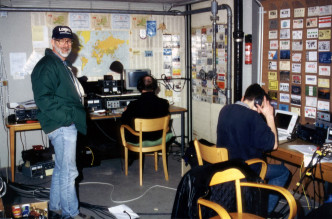Antennas for Multi-TX Sites
Some basic tips for new-comers to multi-transmitter operations.
The biggest problem is cross-talk (interference) between the radios transmitting of different bands.
In some cases there are 2 or more radios transmitting in different modes on the same band.
ANTENNAS:
Use only Monoband Antennas:
- Multi-Band Antennas, such as trap dipoles, trap beams, trap verticals, and full-wave loops receive well on several bands without attenuation. Using these is a no-no.
- Monoband Antennas attenuate out-of-band signals significantly.
Mix Antenna Polarization:
- Use Vertical Polarization for the antenna on one band and horizontal polarization for the antenna on another band. This significantly reduces cross-band interference.
- Consider which bands are likely to be active at the same time and apply the polarization rule above. For instance, unless you are transmitting on all bands at once, 80m and 10m are not likely to be on the air at the same time, but 40m is likely to be used at the same time as 80m.
Antenna Separation:
- Separate antennas as far as feesibly possible.
- Remember, signal strength deteriates significantly with distance.
Antenna Orientation:
- Orient horizontal dipole antennas such that the end is pointing towards the other antenna that it might conflict with.
- Even though this may mandate using a longer coax, the fraction of a dB additional loss in transmitted signal is trivial compared to the many dB of interference attenuation when receiveing on the other antenna.
Use a Common Mode Current Choke (RF Choke) with each Radio:
- An RF Choke (at the radio) helps reduce the signal strength of RF picked up by the transmission line, which can also act as an antenna on its run between the antenna and the shack.
- Not all RF Chokes were created equal. The old Rule of Thumb that the choke need only have 10x as much Common Mode Impedance (CMI) as the transmission line (i.e., 500 Ohms) is very wrong. Good chokes have 1500 to 2000 Ohms. Really good chokes have much more but are typically bandwidth limited.
- Information for designing and building RF Chokes is found HERE.
- 1:1 Guanella Choke
- D-i-Y Tuner Balun (info on core types and turns count)
Bandpass Filters (BPF):
- Bandpass Filters significantly reduce Cross-Talk Reduction in multiple transmitter operations.
- When used in the transmitter circuit, the benefits are multiplied because it is effective in TX and RX modes. The transmitter's harmonics, sub-harmonics and broadband noise are reduced significantly. On receive, the filter reduces harmonics and sub-harmonic signals significantly; but it does not help reduce the broadband noise generated by the transmitters.
- When used (only) in the receiver circuit, it reduces harmonics and sub-harmonic signals significantly; again it does not help reduce the broadband noise generated by the transmitters.
- The best way to reduce transmitted broadband noise is to eliminate it at its source, which means choose another (better/cleaner) transceiver. There are significant differences in the amount of noise that different transmitters produce.
- IMPORTANT: Know the Insertion Loss of the BPF that you deploy.
- Insertion Loss can be as low as 1dB and as high as 6dB.
- BPF's with higher ultimate attenuation use more stages and thus have higher insertion loss. They are great for pre-selectors, but not good for TX BPF's. This is especially true for QRP stations. A 6dB insertion loss reduces a 5 Watt QRP signal to just 1.25 W.


























